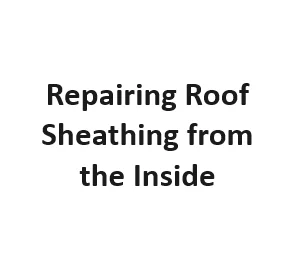Your roof plays a crucial role in protecting your home from the elements, but over time, it may develop issues that need attention. One common problem homeowners face is damaged roof sheathing. While roof sheathing is typically located on the exterior of your roof, there are situations where repairs from the inside become necessary. In this blog post, we’ll explore the reasons behind damaged roof sheathing, signs of trouble, and step-by-step instructions for repairing it from the inside.
Why Does Roof Sheathing Get Damaged?
Roof sheathing is the layer of boards or plywood that provides a solid base for your roofing materials. Several factors can lead to its damage, including:
1. Water Damage:
Water is one of the primary culprits behind roof sheathing damage. Leaky roofs, inadequate drainage, or high humidity can cause moisture to penetrate the sheathing, leading to rot and decay over time.
2. Poor Ventilation:
Inadequate attic ventilation can trap moisture and heat, creating a conducive environment for mold and mildew growth. These microorganisms can weaken and deteriorate the sheathing.
3. Age:
Roof sheathing has a lifespan, and as it ages, it becomes more susceptible to damage. Over time, exposure to sunlight, temperature fluctuations, and weather conditions can take their toll.
4. Pest Infestations:
Insects and rodents can burrow into the sheathing, causing structural damage. This is more common in older homes with untreated wood sheathing.
Signs of Damaged Roof Sheathing
Before repairing your roof sheathing from the inside, it’s essential to identify the signs of damage. Look out for:
1. Sagging or Uneven Roof:
A visually sagging or uneven roofline can indicate underlying problems with the sheathing.
2. Water Stains on Ceilings or Walls:
Interior water stains or discoloration on ceilings and walls can signal a roof leak due to damaged sheathing.
3. Mold or Mildew Growth:
Visible mold or mildew growth in the attic or on the underside of the roof sheathing is a clear sign of moisture-related damage.
4. Soft or Spongy Spots:
Walking in the attic, if you notice soft or spongy areas underfoot, it could be a sign of rotting sheathing.
Repairing Roof Sheathing from the Inside
Once you’ve identified the damage, it’s time to address it. Here’s a step-by-step guide to repairing roof sheathing from the inside:
1. Safety First:
Before you begin, ensure your safety. Wear appropriate protective gear, work in a well-ventilated area, and turn off any electrical systems in the attic.
2. Locate the Damaged Area:
Identify the specific area of damaged sheathing. This may require removing insulation or other materials covering the affected section.
3. Remove Damaged Sheathing:
Carefully cut out and remove the damaged sheathing using a circular saw or reciprocating saw. Be precise to avoid damaging adjacent areas.
4. Inspect the Underlying Structure:
After removing the damaged sheathing, inspect the underlying structure, including rafters and joists, for any signs of damage or rot. Replace any compromised structural components.
5. Install New Sheathing:
Cut a piece of new plywood to fit the area you removed. Ensure it fits snugly and provides proper support. Use nails or screws to secure it in place.
6. Seal Joints and Edges:
Apply a waterproof sealant or flashing tape to the joints and edges of the new sheathing to prevent future water infiltration.
7. Reinforce Insulation and Ventilation:
Before replacing insulation, check and improve attic ventilation to prevent moisture buildup. Then, reinstall or upgrade insulation as needed.
8. Repair Interior Damage:
If there was water damage to your interior, repair any affected drywall or plaster, and repaint as necessary.
9. Regular Maintenance:
To prevent future damage, schedule regular roof inspections and maintenance. Address any issues promptly to extend the lifespan of your roof sheathing.
10. Proper Ventilation:
Addressing the root cause of moisture-related damage is crucial. Ensure your attic has adequate ventilation, including soffit vents, ridge vents, and proper insulation to prevent moisture buildup.
11. Matching Materials:
When replacing damaged sheathing, try to match the type and thickness of the existing material as closely as possible to maintain the roof’s structural integrity and uniform appearance.
12. Safety Measures:
Always prioritize safety. Use the right tools for the job, work on a stable surface, and have someone available to assist you if needed.
13. Consult a Professional:
If you’re uncomfortable with any aspect of the repair process or if the damage is extensive, it’s wise to consult with a professional roofing contractor. They can provide expert guidance and ensure the repair is done correctly.
14. Preventative Maintenance:
Regularly inspect your roof for signs of damage or wear, both from the outside and inside the attic. Catching issues early can save you time and money in the long run.
15. Waterproofing:
Consider applying a waterproofing membrane or coating to the exterior of your roof as an additional layer of protection against moisture intrusion.
16. DIY vs. Professional Help:
While minor roof sheathing repairs can be a DIY project for experienced homeowners, more extensive damage or complex issues may require professional intervention. Assess the severity of the damage before deciding to tackle it yourself.
In Conclusion
Repairing roof sheathing from the inside is a task that demands attention to detail and a commitment to maintaining the structural integrity of your home. By addressing the root causes of damage, taking safety precautions, and following the steps outlined in this guide, you can extend the lifespan of your roof and protect your home from the potentially costly consequences of water damage. Remember that a well-maintained roof not only enhances the aesthetics of your home but also ensures its long-term durability and comfort.


